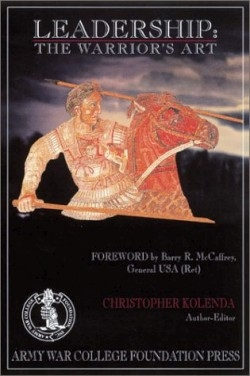Leadership
The Warrior's Art
The concept of basing one’s actions upon orders rather than emotions during times of extreme stress is familiar to the well-trained soldier, but alien to the citizen. It is truly an amazing sight to watch as a massive group “begins to act in concert with its leader.” The leader is the cohesive element of any team, especially a military one. The editor/author has collected a series of nineteen essays by military and civilian scholars who examine the concept of leadership using historical examples, such as Alexander the Great and combat leaders during World War II, as well as other reflections upon the personalities and tactics of effective leaders. Kolenda also wrote one of the essays.
In Cole Kingseed’s essay “Heroism Under Fire: American Combat Experiences in World War II,” unknown heroes come to stand under the limelight. For example, First Sergeant Len Lomell destroyed a German battery that would have been used against U.S. forces near Pointe du Hoc, despite carrying a fresh bullet in his side. Gordon Sullivan compares, quite effectively, jazz great David Brubeck to battle commander Matthew Ridgway in the most fluid essay in this collection: “Leadership, Versatility, and All That Jazz.” He explains the need for a leader to become an expert in his field, to learn the ability to translate “solo excellence” to an entire group, and to be educated enough to “improvise on a theme” when necessary.
The most interesting and bizarre chapter is a short story about a futuristic battle titled “The Battle of Oom Chalouba, 17 June 2008: The Leader’s Role in Preparing Units for the Physical Demands of Combat,” by Mark Hertling. It is not that distant a future and the technology is plausible. The essay refreshes the collection by placing men and women on the battlefield, sharing equal time and responsibility.
Most of the essays use historical examples to demonstrate specific techniques of leadership, like “Calculation and Circumstance: The Leadership of Frederick the Great,” by Dennis Showalter. John Woodmansee’s “Unleashing Human Potential: The Leader’s Role in Creating the Climate for High Performing Organizations,” explains the process of drawing out the best qualities in people and inspiring a group to work together as a well-functioning machine.
Many of the essays are not detailed enough to make this book a precise manual on how to become a great leader, but the collection and the extensive footnotes will guide the curious reader to further study.
Disclosure: This article is not an endorsement, but a review. The publisher of this book provided free copies of the book to have their book reviewed by a professional reviewer. No fee was paid by the publisher for this review. Foreword Reviews only recommends books that we love. Foreword Magazine, Inc. is disclosing this in accordance with the Federal Trade Commission’s 16 CFR, Part 255.

